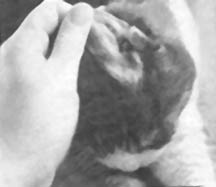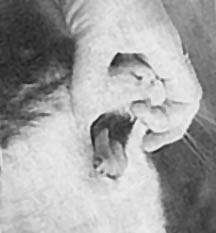In-Home Cat Exams
by Joelle Steele

Cats are very good at hiding any signs of illness, sometimes until their condition is advanced and treatment is difficult, costly, or, unfortunately, too late. By giving your cat an in-home examination on a regular basis, you may be able to detect illnesses and disorders before they become serious or untreatable.
Scheduling An Exam
The best time to give you cat an examination is when they are relaxed or are already being handled. For many cats, grooming time is the best time because you are already cleaning their ears and clipping their claws and they are, hopefully, used to being physically manipulated for that purpose. Another time which affords an excellent opportunity for an exam is when you are cuddling a very relaxed, possibly even sleepy feline. You may end up doing a little examining here or there at different times depending on the mood of your cat. The more familiar you become with what is normal for your cat, the more easily you will be able to spot what is not.
The Head

The head should be examined first, starting with the ears. Clean away waxy deposits from the ear using a soft cotton swab and check for signs of mites (little brown specs), swellings, unusual growths, or signs of infection. Do not insert the swab deeply as you could permanently damage the ears. If mites are present, you will need to have them treated by your veterinarian.
Next, check the eyes and nose. Look at the eyes and check for any differences in the size of the pupil from one eye to the other (can indicate a head or brain injury), and note where the white membrane is situated under normal health conditions for your cat. Lift the lids up and look inside for any swellings, excessive redness, or unusual discharges. The nose is not easy to clean because it is so small, but the nose leather should be examined for cracking or dryness or any sign of irritation. Discharge from the eyes or nose is not a cause for alarm and should be wiped away with a soft, damp cloth. But, if such discharge persists for more than a few days it could be a sign of a respiratory illness or infection and a trip to your veterinarian is in order.

The mouth is often the most difficult part to examine. Most cats simply do not like having their jaws pried open, even if it is in the interest of good oral hygiene. Put your hand over the top of the nose and eyes and secure your thumb and forefinger (or middle finger) at the jaw, slipping both into the mouth enough to force the mouth open. You will have to look fast and may have to open the mouth more than once to thoroughly examine the interior.
Look for broken or discolored teeth, missing teeth, tartar buildup, inflamed gums, sores, cuts, discharges, and foul breath (not just the smell of a recent fish lunch). Look at the “lips” and chin area for any sores, rashes, or inflammations. Mouth problems, dental ones in particular, can cause a cat to be lethargic, ill-tempered, or excessively thin (due to discomfort in eating), and should be attended to immediately by your veterinarian.
Skin and Body
Since a cat’s body is covered with fur, examining the skin for tumors or injuries can take some time. If you examine the body while petting your cat, they will grow to associate your touching with the cuddling and will be more likely to allow you the opportunity to lift their legs and palpate underneath them and to do the same around their nipples (where I found a cancerous lump on Callie), and all other areas of the body. Notice any areas where your cat may appear overly sensitive or where he or she gets downright angry when you touch (a hiss or growl will tell you if such a place exists). Pet the fur very gently in a backwards direction to check for sores, tumors, bites, fungal infections, etc.
Examining a cat’s feet is difficult if your cat was never made accustomed to having them touched while still a kitten, but, if the cat is very relaxed (when they are asleep is a good time), you can usually get a pretty good look. And, last but not least, the anal and genital areas should be checked. Again, do this when the cat is very relaxed and look for swelling or redness, discharge, or foul, fetid odors (not your everyday garden-variety fecal smell).
By examining your cat every month (preferably starting when they are still very small kittens), and always making it a loving, cuddling-type experience, they will eventually not resist your probings and will just come to associate an exam with any other regular, routine activity.
This article last updated: 03/17/2015.
The articles on this website are informational only and are not intended to be a substitute for professional veterinary advice or treatment. Cats are not “one size fits all.” They are different in terms of breed, age, health, lifestyle, and tolerance for different foods and other substances.
